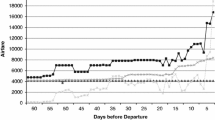Abstract
This paper investigates the impact of the U.S.' policy of “proportionate return of inbound traffic” (PRP) on the prices of outbound U.S. international calls. A quantity-setting model is used to reflect the strategic importance of quantity as a choice variable under PRP. With competitive U.S. carriers, the PRP reduces the total effective costs to U.S. carriers by preventing whipsawing of U.S. carriers by the foreign monopoly carrier—thereby lowering prices. But, the PRP is not effective in lowering prices if U.S. carriers collude. The analysis has important implications for the recent U.S. reform of the International Settlements Policy.
Similar content being viewed by others
References
Acton, J. P., and I. Vogelsang. 1992. “Telephone Demand Over the Atlantic: Evidence From Country-Pair Data.” Journal of Industrial Economics XL(3): 305–323.
Baker, J., and T. Bresnahan. 1988. “Estimating the Residual Demand Curve Facing a Single Carrier.” International Journal of Industrial Organization 6: 283–300.
Carter, M., and J. Wright. 1994. “Symbiotic Production: The Case of Telecommunications Pricing.” Review of Industrial Organization 9: 365–378.
Cheong, K., and M. Mullins. 1991. “International Telephone Service Imbalances.” Telecommunications Policy (April): 107–118.
Choi, H.-W., K.-L. Yun, I. J. Kim, and B.-Y. Ahn. 1999. “On the Economics of Callback Services.” Journal of Regulatory Economics 15: 165–181.
Dixit, A. 1988. “Anti-Dumping and Countervailing Duties Under Oligopoly.” European Economic Review (January): 55–68.
Galbi, D. A. 1998. “Cross-Border Rent Shifting in International Telecommunications.” Information Economics and Policy 10: 515–536.
Hakim, S. M., and D. Lu. 1993. “Monopolistic Settlements Agreements in International Telecommunications.” Information Economics and Policy 5: 145–157.
Hwang, H., and C.-C. Mai. 1988. “On the Equivalence of Tariffs and Quotas under Duopoly: A Conjectural Variation Approach.” Journal of International Economics (May): 373–380.
Johnson, L. L. 1989/91. “Dealing with Monopoly in International Telephone Service: A U.S. Perspective.” Information Economics and Policy 4(3): 225–247.
Karikari, J. A. 1992. “Tariffs versus Ratio Quotas under Oligopoly.” International Economic Journal 6(3): 43–48.
Karikari, J. A., and K. Gyimah-Brempong. 1999. “Demand for International Telephone Services Between U.S. and Africa.” Information Economics and Policy 11: 407–435.
Kwerel, E. 1984. “Promoting Competition Piecemeal in International Telecommunications.” OPP Working Paper Series. 13 (December). Federal Communications Commission, Washington, D.C.
Lande, J., and L. Blake. 1997. Trends in the U.S. International Telecommunications Industry. (June). Federal Communications Commission, Washington, D.C.
Madden, G., and S. Savage. 2000. “Market Structure, Competition and Policy in United States International Telephone Services Markets.” Review of Economics and Statistics (May): 291–296.
Maggi, G. 1996. “Strategic Trade Policies with Endogenous Mode of Competition.” American Economic Review (March): 237–258.
O'Brien, D. P. 1989. The Uniform Settlements Policy in International Telecommunications: A Noncooperative Bargaining Model of Intermediate Product Third Degree Price Discrimination. Ph.D. Dissertation, Department of Economics, Northwestern University, Evanston, IL.
Sandback, J. 1996. “International Telephone Traffic, Callback and Policy Implications.” Telecommunications Policy 20(7): 507–512.
Scanlon, M. 1996. “Why is the International Accounting Rate System in Terminal Decline, and What Might be the Consequences?” Telecommunications Policy (June): 739–753.
Scanlon, M. 1998. “Using Call-Back to Demonstrate the Discriminatory Nature of the Proportionate Return Rule.” Telecommunications Policy 22(11): 913–930.
Stanley, K. B. 1991. “Balance of Payments, Deficits, and Subsidies in International Communications Services: A New Challenge to Regulation.” Administrative Review (Summer): 411–438.
Taylor, L. D. 1980. Telecommunications Demand: A Survey and Critique. Cambridge, MA: Ballinger.
Wright, J. 1999. “International Telecommunications, Settlement Rates, and the FCC.” Journal of Regulatory Economics 15(3): 267–291
Yun, K.-L., H.-W. Choi, and B.-H. Ahn. 1997. “The Accounting Revenue Division in International Telecommunications: Conflicts and Inefficiencies.” Information Economics and Policy 9(1): 71–92.
Author information
Authors and Affiliations
Rights and permissions
About this article
Cite this article
Karikari, J.A. Pricing Implications of U.S.' International Settlements Policy. Journal of Regulatory Economics 20, 269–283 (2001). https://doi.org/10.1023/A:1011167009990
Issue Date:
DOI: https://doi.org/10.1023/A:1011167009990




